Market briefs
Breaking insights on the economy, market volatility, policy changes and geopolitical events
Talking money with family and friends over the holidays
FROM SURGING STOCK PRICES to higher consumer costs and a difficult job market, the economy and markets have dominated headlines in 2025. “That makes money a natural subject as you gather with family and friends for the holidays,” says Aditya Bhave, senior U.S. economist for BofA Global Research.
To help inform those conversations and give you a view into where things may be headed in 2026, Bhave and his BofA Global Research colleague Savita Subramanian, head of U.S. Equity and Quantitative Strategy, recently sat down with Chief Investment Officer Chris Hyzy for an insight-packed discussion, “Outlook 2026: Expert views on equities and the economy.”
Watch (and share) it, along with the entire suite of Outlook 2026 videos, available on our Today’s Markets page and YouTube channel, with family and friends. As an added bonus, below, Bhave offers some surprising stats to sprinkle into your conversations whenever the following money questions come up during your holiday get-togethers.
Q: This is turning out to be an expensive holiday season. What’s causing the inflation?
Actually, prices haven’t spiked as much as many people feared when tariffs were first announced in 2025, says Bhave. They’ve declined from last year on items such as computers, sporting equipment and clothing.1 Still, with the Federal Reserve cutting interest rates, inflation, which now stands at around 3%, may remain sticky over the next year.

The same likely holds true for housing costs. While mortgage rates might come down slightly, solid demand and limited supply could keep home ownership out of reach for many first-time buyers. “Did you know,” says Bhave, “that the median age of first-time homebuyers reached an all-time high of 40 in 2025, compared with 33 in 2020?”2
Q: Will my kids be able to find work in this tight job market after they graduate?
“In early 2022, there were nearly two job openings for every unemployed person.3 This year that number dipped below one,”4 Bhave says. But government stimulus contained in the 2025 One Big Beautiful Bill Act, along with lessening uncertainty about trade policy, could help kickstart hiring. “It may take time, but next year’s holiday conversations could be cheerier.”
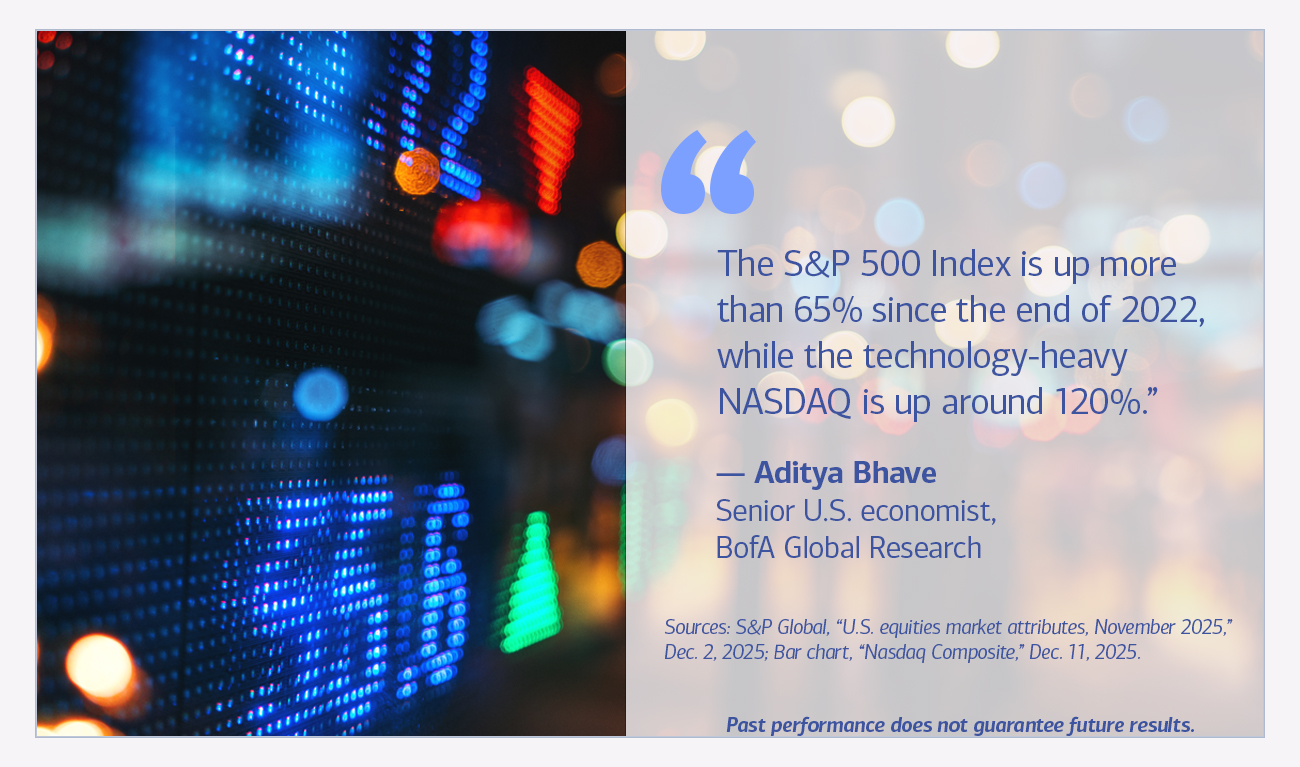
Q: With all the concerns over the economy, why is my portfolio doing so well?
Even as artificial intelligence (AI) pressures the job market, optimism over its ability to make businesses more efficient has helped drive markets higher. “The S&P 500 Index is up more than 65% since the end of 2022,5 while the technology-heavy NASDAQ is up around 120%,6” says Bhave. While the soft labor market is a concern, he adds, ongoing Fed interest rate cuts are seen as a positive for equities. Meanwhile, though inflation and job uncertainty are pressuring less affluent consumers, wealthy consumers continue to spend, thanks in part to those stock market gains.
Q: Speaking of AI, what are data centers, anyway? And why is everyone talking about them?
“Think of data centers as the heartbeat of the AI boom,” says Bhave. Companies have invested billions of dollars in these structures that house all the necessary computing infrastructure for AI, and that investment has helped to drive growth in construction, as well as related industries such as software, equipment, servers, energy and more. Adds Bhave: “As the latest Outlook 2026 video suggests, investors could explore the companies potentially benefiting from this enormous capital expenditure.”
Tune in regularly to the Chief Investment Office’s Market Update audiocast series for ongoing insights on the economy and markets in the new year.
1U.S. Bureau of Labor Statistics, “Table 2. Consumer Price Index for all urban consumers (CPI-U): U. S. city average, by detailed expenditure category,” Oct. 24, 2025, prices September 2025 vs September 2024.
2National Association of Realtors, “First-time home buyer share falls to historic low of 21%, median age rises to 40,” Nov. 4, 2025.
3PBS News, “U.S. job openings remain high, with nearly twice as many openings as unemployed people,” June 1, 2022.
4Mises Institute, “The US now has more unemployed people than job openings,” Sept. 9, 2025.
5S&P Global, “U.S. equities market attributes, November 2025,” Dec. 2, 2025.
Ready to get started now? We are, too.
In time for the holidays — the latest interest rate cut
THE FEDERAL RESERVE (THE FED) DELIVERED what some consider an early holiday gift on December 10, cutting the federal funds rate by .25% for the third time this year. The widely anticipated cut, aimed at boosting the economy, could contribute to a “Santa Claus rally,” with markets rising in the last days of December and into the start of the New Year,1 says Chris Hyzy, Chief Investment Officer for Merrill and Bank of America Private Bank.

Additional cuts for 2026?
Longer term, the Fed’s rate-cutting goal is to spur job creation in a softening labor market. “Current expectations call for two or even three additional cuts in 2026, depending on who the next Fed chair is,” Hyzy notes. The term of current Chair Jerome Powell ends next May, and a successor could be named this month.2
What it could mean for the markets and investors
Businesses’ borrowing demands and banks’ willingness to lend were rising even before the December 10 announcement.3 “Additional cuts, combined with a reopened government, One Big Beautiful Bill Act stimulus, and fading tariff effects all support our expectations of double-digit corporate earnings growth in 2026,” he adds.
Among the risks to watch for, rate cuts could reignite stubborn inflation, dampening consumer spending at a time when many families already have concerns over prices and job security. And a lack of economic data stemming from the government shutdown has created challenges for the Fed in balancing its two biggest priorities, full employment and moderate inflation, as it makes rate decisions moving forward. “These risks and opportunities underscore the importance for investors to maintain a balanced, diversified portfolio and invest steadily towards their long-term goals,” says Hyzy.
For a full preview of the year ahead, be sure to watch our Outlook 2026 webcast, “Powering up: What could drive the next era of growth?” and check out additional year-ahead insights, including “Outlook 2026: Geopolitics, policy and your portfolio” and “Outlook 2026: Will consumer spending stay strong?” For regular updates on interest rates and other market conditions, listen to our latest CIO Market Update audiocast.
RESILIENCE — THAT’S THE WORD that stands out when investors look back at the U.S. economy and markets in 2025. Despite historic disruption, the economy has so far held firm, with equities extending a bull market into its fourth year, even amid periodic volatility. Now it’s time to look forward. “It’s Outlook season again — that time of year when we pause, reflect and analyze what the next 12 months could mean for investors,” says Chris Hyzy, Chief Investment Officer for Merrill and Bank of America Private Bank.
Watch the video above for an early look at the risks and potential opportunities the Chief Investment Office (CIO) expects in the year ahead, as well as some powerful long-term trends that could continue to drive momentum beyond 2026. Then save the date and be sure to watch the full 2026 Year Ahead Outlook, “Powering up: What could drive the next era of growth?” debuting on November 24, and available on demand afterwards.
For ongoing insights on the markets and economy throughout the year, tune in regularly to the CIO Market Update audiocast.
Don’t let dot-com bubble flashbacks sidetrack your investing strategy
WITH ARTIFICIAL INTELLIGENCE AND other technologies propelling markets in 2025, some investors are wondering if there are parallels to the internet bubble of the late 1990s.1 But the market landscape is not the same today, says Theadora Lamprecht, investment strategist for the Chief Investment Office (CIO), Merrill and Bank of America Private Bank.
“Compared with the dot-com run-up in the late 1990s, we’re in a healthier environment fueled by fundamentals rather than speculation,” she says. Given short-term volatility — for example, the recent selloff in the tech-heavy NASDAQ Index2 — sentiment may not fully reflect the solid fundamental backdrop that exists. A new report in the November 3 Capital Market Outlook, “Blast from the past? Not this time,” offers reasons for calm.
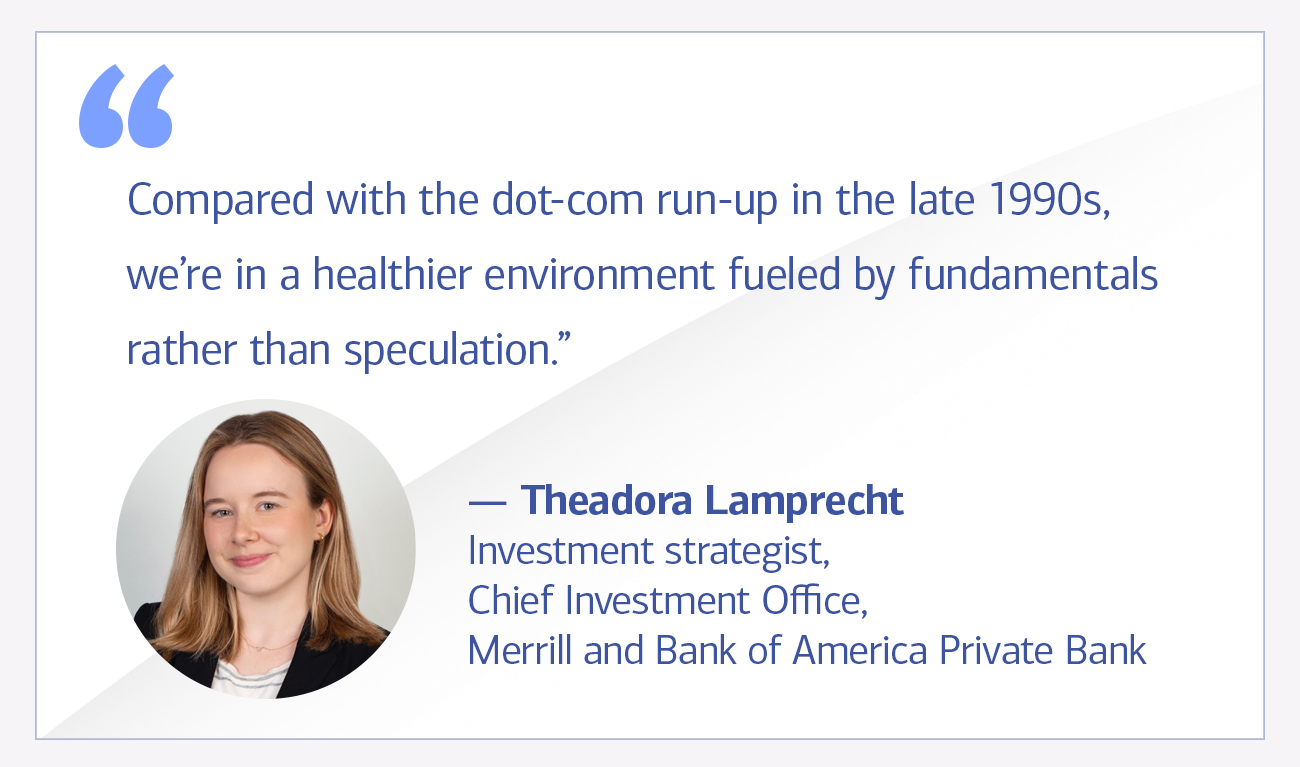
What’s different this time?
Rational investors. “Amid the ‘irrational exuberance’ of the late 1990s, NASDAQ’s price-to-earnings ratio, which measures the index’s value by comparing its current market price to its earnings per share, rose to 91X. It’s only around 32X currently,”3 Lamprecht notes. “Instead of overconfidence, the AAII Investor Sentiment Survey through 2025 shows investors feeling relatively bearish. As sentiment is often viewed as a contrarian indicator, this suggests further room to run.”4
Sound fundamentals. “Strong corporate earnings, easier monetary policy, the benefit of seasonality and the beginning of a massive digital infrastructure buildout provide a solid foundation for potential growth,” she says.
Broadening markets. “Ten of 11 industry sectors on the S&P 500 are expected to post positive earnings growth for 2025,” Lamprecht adds. “While mega-cap tech companies still dominate markets, this suggests a broadening of performance beyond technology.”
Stick with your strategy
While volatility is part of investing, the biggest risk could be disrupting your long-term strategy or exiting markets in anticipation of a downturn. “Even if markets temporarily decline, you could miss out on potential gains or face higher costs to buy back in when markets recover,” Lamprecht says. “We recommend staying the course with a diversified portfolio based on your goals.” Rebalance as necessary and look at short-term volatility as a potential buying opportunity, she suggests.
Read the November 3 Capital Market Outlook for more insights on current market valuations. For regular updates on the markets and economy, tune in to our CIO Market Update audiocast weekly.
Federal Reserve rate cutting stays on pace
THE FEDERAL FUNDS RATE DROPPED by .25% on Wednesday, October 29 – the second such cut in two consecutive months – as the Federal Reserve (the Fed) seeks to spur U.S. hiring without reigniting inflation.1 And there may be more to come. “We’re still at the early stages of the Fed easing cycle,” says Chris Hyzy, Chief Investment Officer for Merrill and Bank of America Private Bank. A third 2025 cut could possibly come in December, according to market participants, with markets forecasting additional cuts into 2026.
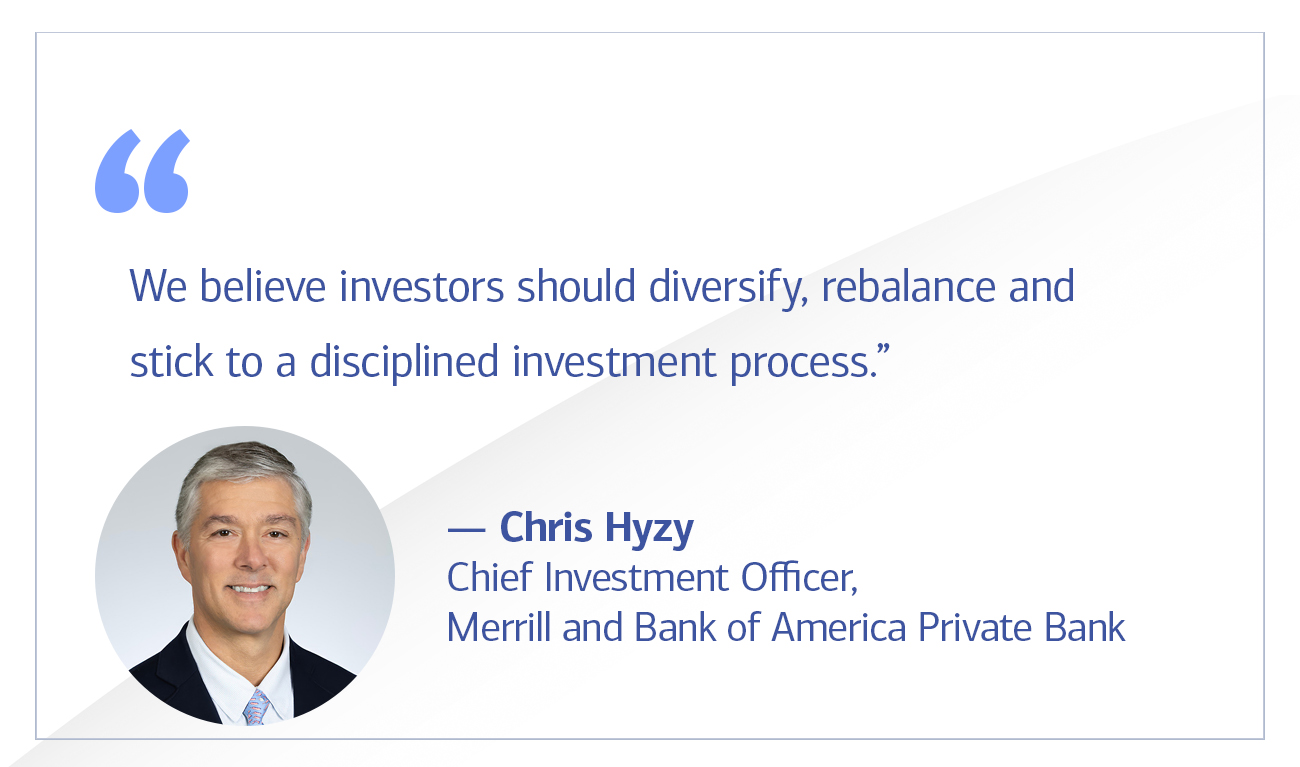
Cutting amid labor uncertainty
The Fed announced its first cut since December 2024 in September, after August labor numbers showed an uptick in unemployment and the economy was adding fewer jobs than anticipated. New labor statistics have been harder to come by since the federal government shutdown began October 1, but recent inflation figures have offered some reassurance, Hyzy notes. Consumer prices saw a 3% jump in September; while still higher than the Fed’s 2% target, that number came in slightly lower than expectations.2
Moves for investors to consider
“Because rate cutting makes borrowing easier for businesses and consumers, it generally supports stock market growth,” Hyzy says. Noting that the current cuts come amid a period of massive, long-term investment in digital infrastructure to support AI and other technologies, he adds, “We believe investors should diversify, rebalance and stick to a disciplined investing process.”
See the September 17 Market Brief for additional ideas on investing amid rate cuts. And listen to our latest CIO Market Update audiocast for updates on interest rates and other conditions.
As gold rises, are concerns about the dollar overblown?
GOLD CONTINUES TO MAKE NEW FRIENDS among investors, with prices surpassing $4,000 an ounce for the first time in early October.1 The precious metal’s climb hit a speed bump this week as traders took profits and prices dropped slightly,2 but global factors driving gold’s rise remain intact, believes Ehiwario Efeyini, senior market strategy analyst, Chief Investment Office (CIO), Merrill and Bank of America Private Bank.
While a welcome development for gold owners, this year’s surge reflects growing concerns over potential debasement, or devaluation, of the U.S. dollar. In the CIO’s October 20 Capital Market Outlook, Efeyini explores reasons for the dollar’s recent decline and the rise of gold, what it might mean for investors and why larger fears for the dollar’s future may be overblown.
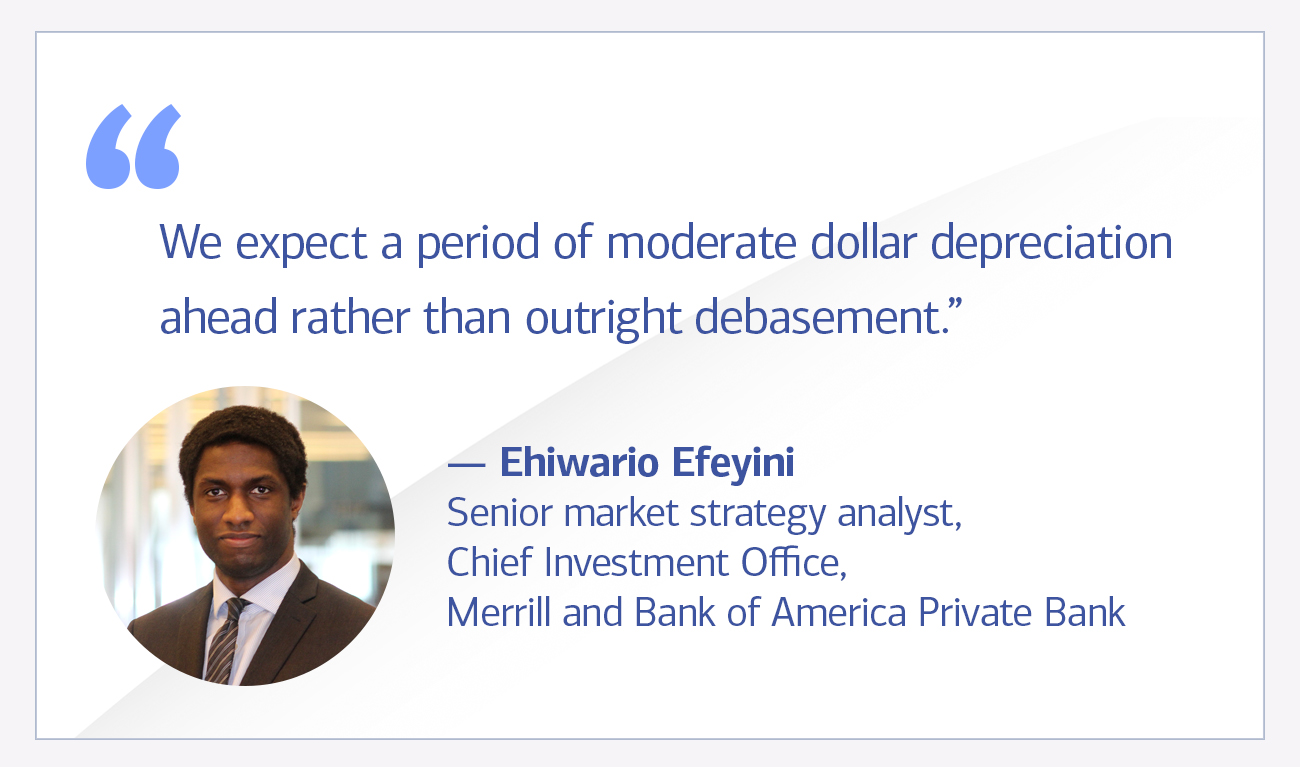
Why gold is rallying
- U.S. debt, inflation and monetary policy: “Amid concerns over excessive government borrowing, debt and spending and persistent inflation, investors are turning to assets such as gold that can preserve purchasing power,” Efeyini says.
- Dollar weakness: The dollar, overvalued in recent years relative to other global currencies, has declined about 10% through the third quarter of 2025.3 “Gold historically tends to move inversely with the value of the dollar,” Efeyini adds.
- Central bank purchases: As highlighted in a July Market Brief, global central banks have been buying gold to diversify their holdings. “Emerging market central banks, in particular, have room to add gold and drive prices higher,” he says.
What that could mean for the dollar
U.S. debt and spending levels, while valid concerns, are unlikely to spur a “disorderly decline” of the dollar, Efeyini believes. “The dollar has appreciated through four rounds of quantitative easing since 2008 and federal budget deficits well in excess of 10% of GDP in 2020 and 2021.” In the current environment, he adds, “We expect a period of moderate dollar depreciation ahead rather than outright debasement.”
Rising gold, falling dollar? Consider these moves
“Investors might consider broadening their view of potential opportunities beyond gold to include other precious metals, as well as precious metals producers,” Efeyini says. “This year has seen a surge in price levels across the precious metals complex, including silver, platinum and palladium,”4 notes Efeyini.
Another potential upside for equity investors: by making their products cheaper, today’s weaker dollar benefits U.S. companies with global operations and exports, while creating challenges for companies that export to the U.S. If you work with an advisor, you might discuss your exposure to both. As always, investment decisions should align with your long-term goals, time horizon and risk tolerance, he adds.
For a deeper dive into gold and the dollar, read “Should Markets Be Concerned About Dollar Debasement?” Listen to our latest CIO Market Update audiocast, and check here for regular updates on interest rates and other economic and market conditions.
Defense spending surges: What investors should know
AS NATIONS RE-ARM AND MILITARIES MODERNIZE, a new “security supercycle” is building. “Investments are being made in everything from traditional aerospace and defense systems to cybersecurity, drones, AI-driven defense shields, hypersonics and satellite networks,” says Lauren J. Sanfilippo, senior investment strategist in the Chief Investment Office (CIO) for Merrill and Bank of America Private Bank. As a result, global military expenditures reached a record high of $2.7 trillion in 2024.1 It stands as a compelling, structural and, most important, investable supercycle for investors to consider.

How we got here
“The Russia-Ukraine war, at 3.5 years and counting, has forced every European nation to rethink and retool their defense postures and readiness,” Sanfilippo says. “The scrambled geopolitical landscape of the Middle East has added to the demand for arms and munitions, and the United States and countries across Asia are responding to China’s growing military might.” History suggests there’s room for growth ahead, Sanfilippo believes. Last year’s $2.7 trillion, while a new high in dollar amounts, represents just 2.5% of world GDP — that’s nearly a percentage point less than the annual average in global defense spending from 1960 to 2024.1
Defense stocks on the radar
Traditional defense industries are getting a boost as the U.S. and other nations update outdated equipment. “We believe aerospace is entering a multiyear upcycle driven by the arms race, as well as airlines’ need to upgrade fleets to meet travel demand,” Sanfilippo says.
Investors may also find opportunities in emerging technologies that are rapidly moving from “what if” to implementation. “Modern warfare increasingly relies on artificial intelligence, hypersonics and quantum computing,” she adds. “As two examples, the U.S. allocated about $55 billion in 2025 to developing emerging technologies in space and command, control, communications, computers and intelligence systems, while Japan invested $3.6 billion on missile defense against hypersonic and ballistic missile threats.”2
Stay alert to high valuations
All this activity has boosted defense stocks in Europe and the United States. As you consider these areas, “one potential risk involves overpaying for companies that may be trading at a premium,” Sanfilippo says. Temporary market downturns could provide potential opportunities to buy at attractive prices, and an advisor can help you determine whether and how this sector aligns with your goals.
For more on the defense and aerospace sector, read “The Security Supercycle: Arms, Aerospace and Algorithms” in the September 22 issue of Capital Market Outlook. Tune in regularly to the CIO’s Market Update audiocast for regular updates on the markets and potential investing opportunities.
Will markets take the government shutdown in stride?
THE FEDERAL GOVERNMENT SHUT DOWN one minute into October, after Congress and the administration failed to reach a stopgap spending agreement at midnight on September 30. So far markets seem to be taking a wait-and-see attitude to the news, despite expected widespread disruption of all but the most essential government services and the furloughing of thousands of federal workers.

The risks: What we’re watching
In large part, that may be due to the strength of the equity markets in the lead up to the shutdown, says Chris Hyzy, Chief Investment Officer for Merrill and Bank of America Private Bank. “Stocks opened the week on a positive note, thanks to better-than-expected economic news out of Asia and Europe and optimism over third- and fourth-quarter U.S. earnings.” History also tells us that “the wider economic impact of government shutdowns has tended to be modest and short-lived,” Hyzy adds.
But there are risks: “An extended shutdown could ultimately create periodic market volatility and impact economic growth,” Hyzy believes. “We’ll be closely watching credit spreads, the equity markets and short-term interest rates for signs of stress.”
Another risk: Lack of new economic data, such as a key jobs report due Oct. 3 from the Bureau of Labor Statistics that won’t be released during the shutdown.1 On September 17, the Federal Reserve announced its first interest rate cut since December 2024, to help stimulate a flagging jobs market. “With additional rate cuts expected, jobs and other data will be crucial to determining if financial conditions are easing as intended, and where to go next,” Hyzy says.
What you can do
It’s too early to tell how long it will take for lawmakers and the administration to resolve funding differences and reopen the government. “While the situation bears watching closely, the main thing investors need is patience,” Hyzy explains. “This is not something that should cause you to alter your long-term investing strategy,” he adds. “Any short-term volatility related to the shutdown may just create potential opportunities to add strategically to your portfolio.” If you work with an advisor, now might be a good time to check in to discuss the potential risks and opportunities.
For more insights regarding the shutdown, read the CIO’s latest Investment Insights, tune in regularly to the CIO Market Update audiocast, and check here often for updates as the shutdown continues.
How to prepare for a possible government shutdown
PUSH MAY BE COMING TO SHOVE. Barring an eleventh-hour agreement to continue funding the government past midnight on September 30, a partial government shutdown will begin on October 1, and it won’t end until a continuing resolution is passed by both houses of Congress and signed into law.1
Which government services would be suspended?
There are exceptions for specified, essential government services, including Social Security and Medicare, airport security and air traffic control, national defense and Treasury debt payments, with employees involved in those functions required to work without pay. Most other agencies, though, will stop operating and furlough their workers. (The White House Office of Management and Budget has reportedly warned programs that aren’t required by law to prepare for workforce reductions if a shutdown occurs.2)
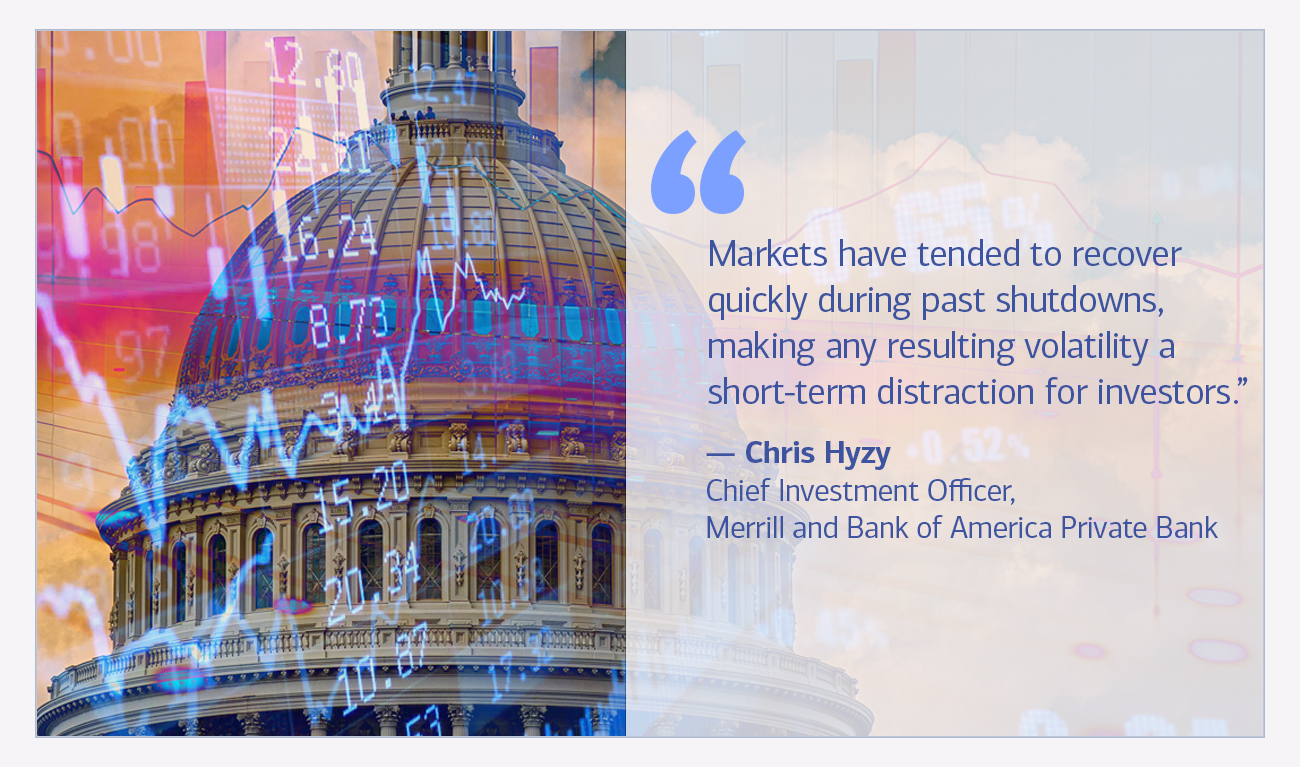
What could a shutdown mean for investors?
Although a partial government shutdown would be disruptive, especially for federal workers and those who depend on many government services, it’s not likely to have much impact on financial markets, says Chris Hyzy, Chief Investment Officer for Merrill and Bank of America Private Bank. “Markets have tended to recover quickly during past shutdowns, making any resulting volatility a short-term distraction for investors.”3
Some historical perspective: There have been 14 other partial shutdowns since 1981. Many have been very brief, but the most recent, from late December 2018, lasted 34 days. S&P 500 returns during the three, six and 12 months after that shutdown were 15.8%, 21.9% and 33.4%, respectively.3
How could a shutdown affect the economy?
A shutdown would likely underscore continuing policy disputes, adding to uncertainty and concerns about rising government debt and deficits. Still, “we believe the economy will likely quickly recover any losses during the shutdown, and any market volatility is likely to subside once the government reopens,” says Hyzy.
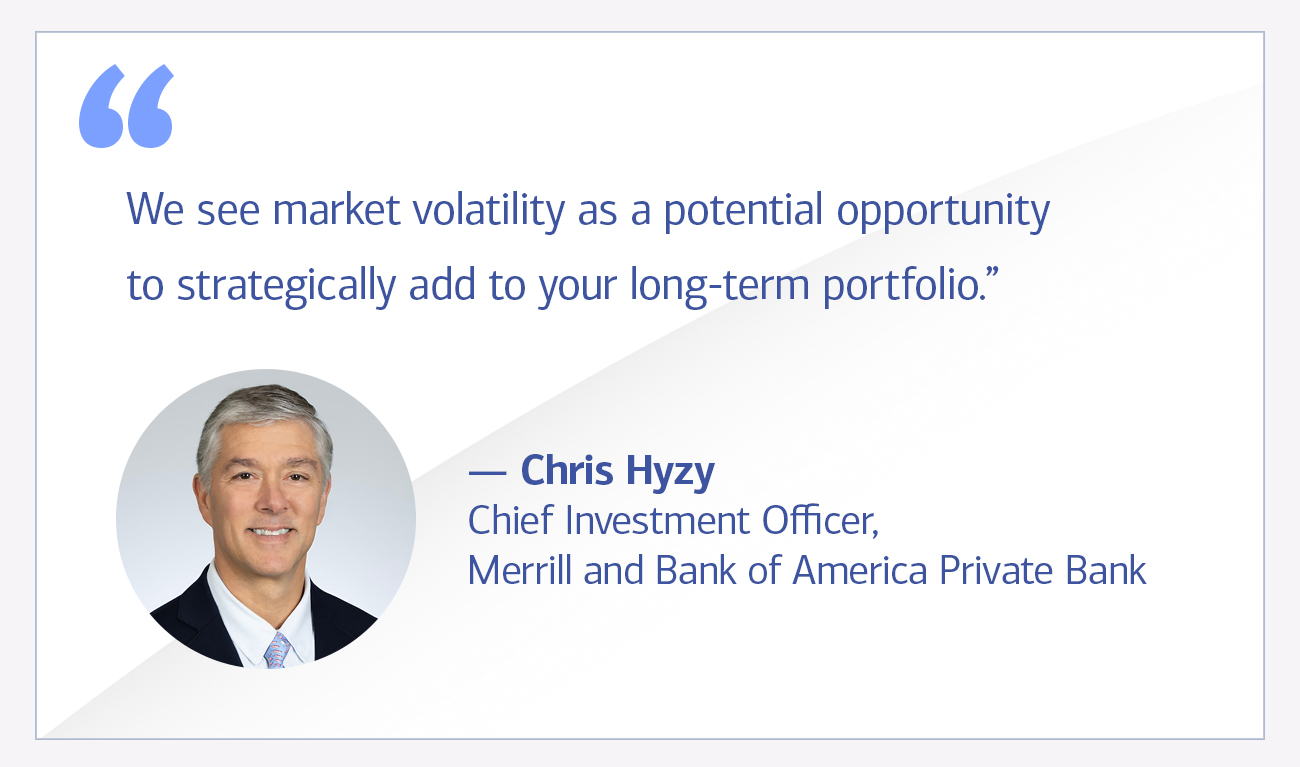
How can investors respond?
For investors, the most important guidance is to avoid taking precipitous actions based on daily headlines or predictions of which way the market will head next, he says. “While the ups and downs can be concerning, we see market volatility as a potential opportunity to strategically add to your long-term portfolio, given our overall optimistic view of the current corporate profits cycle.”
Keep in mind, he adds, that missing out on the potential gains that could follow when markets rebound can be costly. If you work with an advisor, now might be a good time to get together and review the risks and potential opportunities the current markets create.
For more insights, read “What you can do when the markets get volatile,” and tune in regularly to the CIO’s Market Update audiocast series.
1ABC News, “The government could shut down in less than a week. Here's what you need to know,” Sept. 24, 2025.
2CNBC, “Trump OMB orders preparation for mass firings of federal workers if government shuts down,” Sept. 25, 2025; Politico, “White House to agencies: Prepare mass firing plans for a potential shutdown,” Sept. 24, 2025.
3Sources: U.S. House of Representatives; Chief Investment Office. Data as of July 2023.
The Fed rate cut: A cue to review your investments
THE FEDERAL RESERVE (THE FED) LOWERED the federal funds rate by .25% on Wednesday, September 17, marking the first Fed rate cut since December 2024. “The Fed has signaled the possibility of two more cuts before year end, with additional cuts possible in 2026,”1 says Chris Hyzy, Chief Investment Officer for Merrill and Bank of America Private Bank.
Is a weakening economy behind the cut?
The Fed typically lowers rates to jumpstart an economy showing signs of slowing. The economy added only 22,000 jobs in August and unemployment, a key concern for the Fed, rose.2 That’s what prompted the much-anticipated rate cut, even though inflation, the Fed’s other key concern, remains higher than its 2% target.
In this case, however, the economic news isn’t all bad. Despite a softening labor market and sticky inflation, “consumers are spending, corporate earnings and capital expenditures remain strong and equity markets have been reaching new highs,” says Hyzy. “With a period of declining rates likely to follow today’s rate cut, investors may want to consider making some portfolio adjustments.”
Lower rates = higher returns?
While markets rallied in advance of the September cut, there are strong indications of additional room to grow, Hyzy believes. In addition to easier access to capital stemming from an easing rate environment, companies are poised to benefit from a host of tax incentives contained in this year’s “One Big Beautiful Bill.”
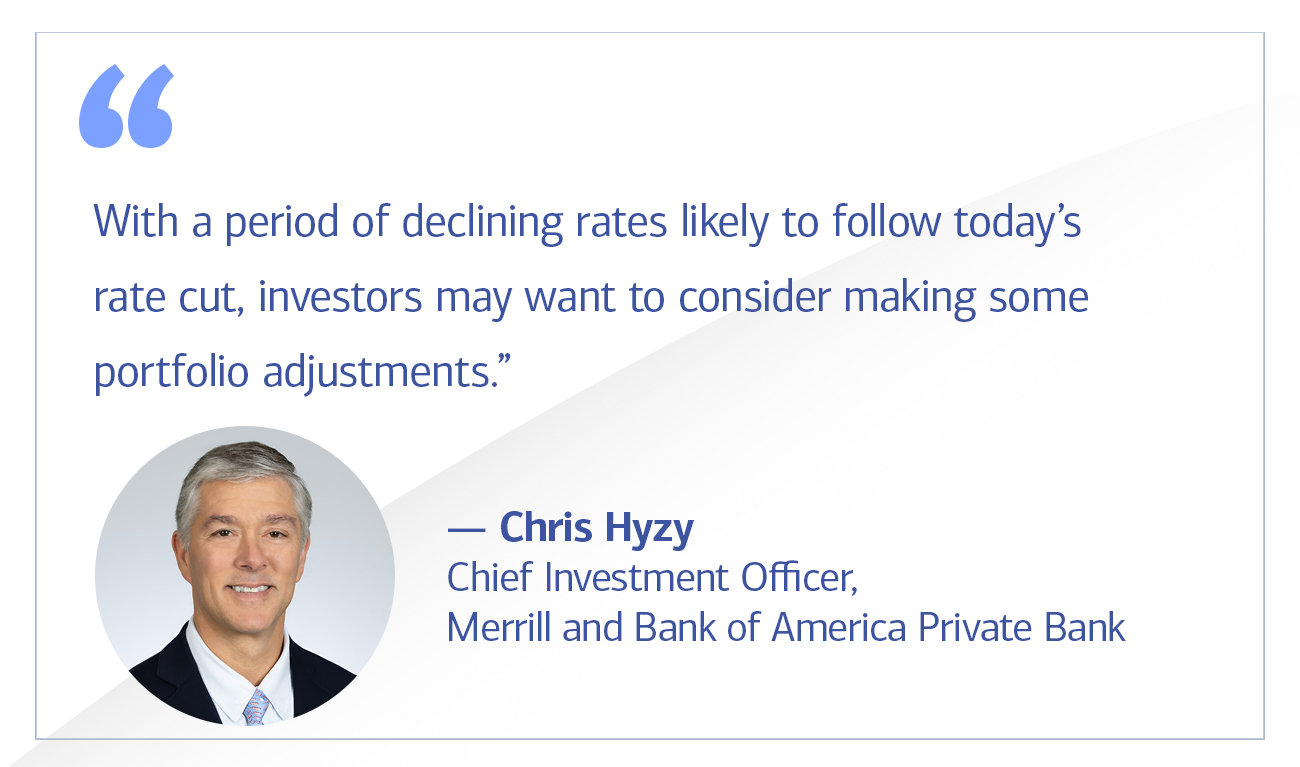
3 moves for investors to consider now
Lock in longer-term bond rates before they fall. “Putting money into longer-term bonds before rates drop further could help you diversify equity risk with higher, more stable income,” Hyzy says. For more insights on how your bond holdings could be affected by an easing rate environment, watch “What do Fed rate cuts mean for the bond market?”
Look for potential buying opportunities. “For growth, we would view any temporary market weakness as an invitation to strategically invest in equities, especially if you have excess cash,” he says. The declining rate environment may create potential opportunities in areas such as real estate, industrials and financials.
Take a look at small-cap companies and infrastructure stocks. Small caps may benefit from easier access to capital. Meanwhile, says Hyzy, the massive buildout of data centers to power artificial intelligence could also create long-term opportunities in infrastructure.
As always, consider diversifying across and within asset classes, and keep in mind that any portfolio changes should align with your long-term goals, Hyzy advises. For help staying on top of the markets, tune in weekly to the CIO’s Market Update audiocast, and check here for updates on interest rates and other economic and market conditions.
Can India reclaim emerging markets leadership?
AFTER HEADLINING THE EARLY 2020s as investors’ favorite emerging market (EM) economy, India in 2025 has lagged the broader universe of EM stocks by about 18%.1 “And while the MSCI India Index outperformed the Chinese MSCI Index by nearly 100% between 2020 and 2024,2 that script has flipped with Chinese equities soaring in 2025 and India flattening,” says Ariana Chiu, wealth management analyst in the Chief Investment Office (CIO) for Merrill and Bank of America Private Bank.
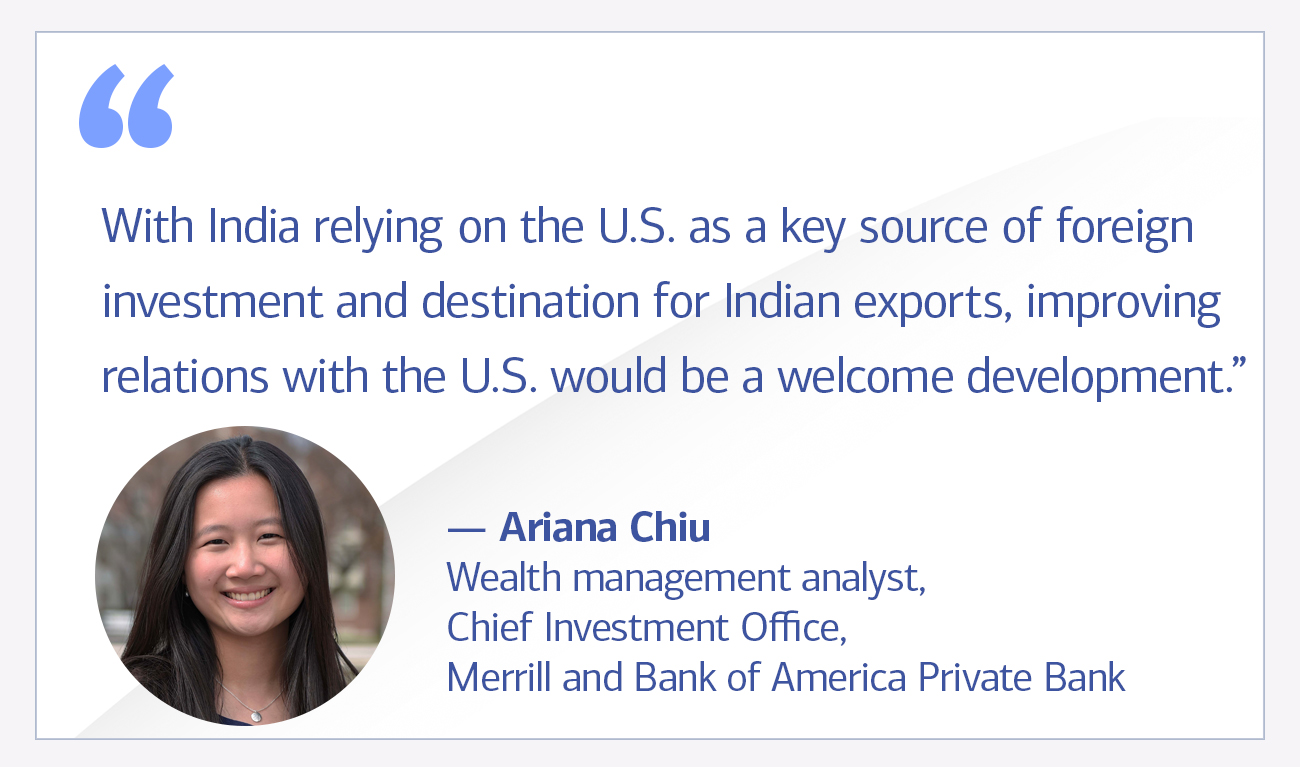
A recent CIO Capital Market Outlook report examines some reasons for India’s tough year for equities, its prospects for turning things around, and what this means for investors.
What’s behind India’s struggles?
“Tariffs are creating headwinds,” Chiu says. Most notably, the United States recently doubled its tariffs on India to a steep 50% in response to India’s purchases of Russian oil.3 “One reason investors had favored India was that, unlike China, it was not thought to be in the crosshairs of U.S. protectionism,” she adds.
Another factor: “Despite hopes that India would emerge as a supply chain alternative to China, its share of global manufacturing has barely budged over the past 15 years,” Chiu notes.4 “Meanwhile, China’s technology strength has helped drive that country’s improving equity momentum.”
Reasons for optimism
“Despite challenges, India remains the world’s fastest growing major economy,” Chiu says. The country’s real GDP growth reached 7.8% in the second quarter of 2025, higher than many economists had expected.5 “With India relying on the U.S. as a key source of foreign investment and destination for Indian exports, improving relations with the U.S. would be a welcome development,” she adds.
How should investors respond?
Considering the ongoing growth in emerging market economies, “We believe a strategic allocation to EM equities can be appropriate in a well-diversified portfolio,” Chiu says. Investors may want to consider funds with active managers closely following the evolving trade picture and country-by-country outlook, she adds. An advisor can help you determine whether EM equities are a good fit for your portfolio and long-term goals.
Read the full Capital Market Outlook report. Listen to our latest CIO Market Update audiocast, and check here for regular updates on tariffs and other economic and market conditions.
1Bloomberg. Data as of Sept. 3, 2025.
2Bloomberg. Data as of Sept. 3, 2025.
3Reuters, “Trump’s doubling of tariffs hits India, damaging ties,” Aug. 27, 2025.
4United Nations. Data through 2024, as of September 2025.
5CNBC, “India’s economy grows at faster-than-expected 7.8% in the June quarter,” Aug. 29, 2025.
Good, bad, ugly: What tariffs could mean for the economy and investors
SINCE ANNOUNCING STEEP TARIFFS ON MOST COUNTRIES in early April, the United States has modified or retracted some tariffs and announced new ones, with varying responses from abroad.1 For investors, tariff uncertainties have raised questions on an array of topics: inflation, corporate earnings, stock performance, even the potential for an all-out trade war.
Although international trade policies are likely to keep evolving, some possible effects are emerging from the noise. In a recent issue of the Capital Market Outlook, the Chief Investment Office (CIO) examined the risks, potential benefits and reasons for long-term optimism on the U.S. economy.
Good: A rebalancing of world trade
“The global trading system has long been overdependent on U.S. buyers,” says Joe Quinlan, head of Market Strategy in the Chief Investment Office for Merrill and Bank of America Private Bank. With just 4.7% of world population, the U.S. accounted for 13.5% of merchandise imports in 2024, according to the International Monetary Fund.
“Over time, higher tariffs may encourage export-oriented countries such as China and Germany to focus more on internal consumption,” Quinlan says, bringing trade into greater balance and creating opportunities for U.S. goods and services exports. Higher tariffs could also generate new revenue for the federal government and could encourage more foreign firms to manufacture in the U.S., he says.
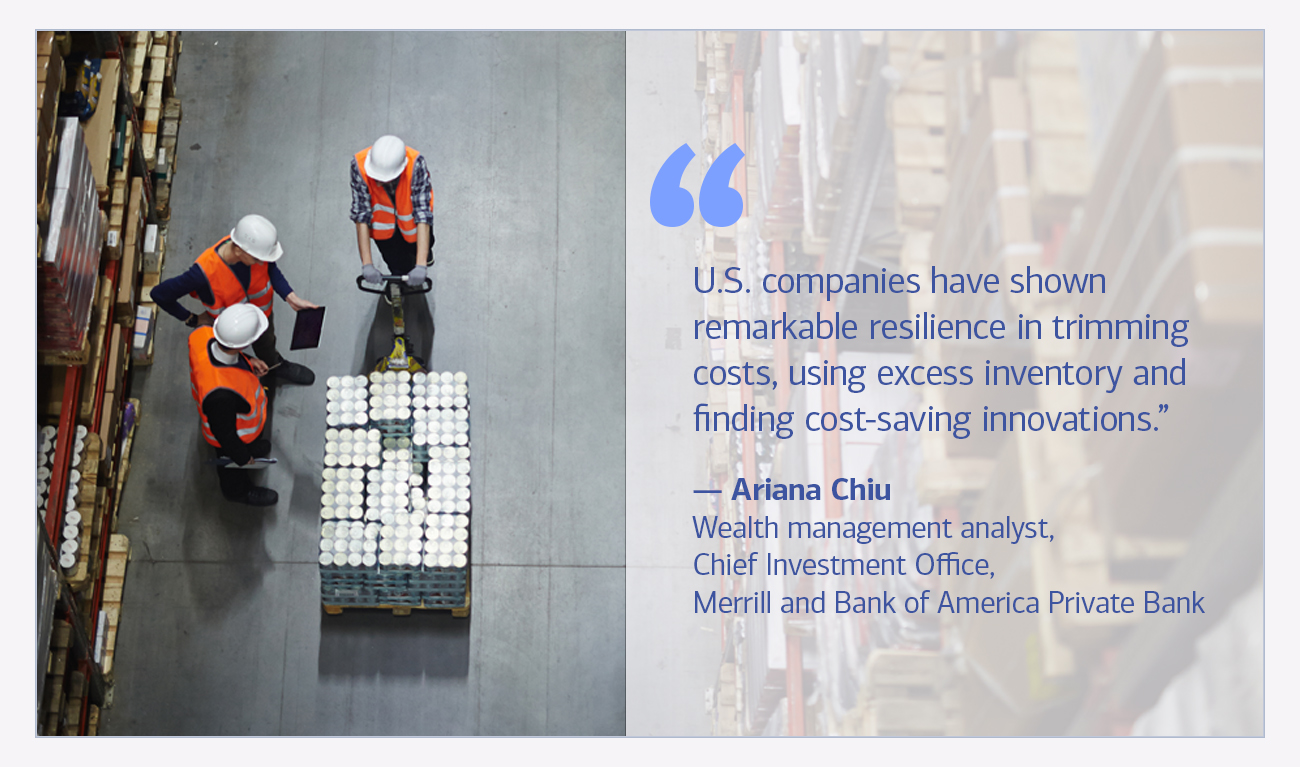
Bad: U.S. companies feeling the pressure
“Despite those potential long-term benefits, tariffs are already hitting U.S. corporate bottom lines in industries as diverse as autos, food, clothing and construction,” says Ariana Chiu, wealth management analyst in the CIO. While many companies have thus far avoided passing increased costs on to consumers, 2025 could still see higher consumer prices and a dent in corporate earnings.
On the positive side, “U.S. companies have shown remarkable resilience in trimming costs, using excess inventory and finding cost-saving innovations,” Chiu adds. “And a weaker dollar this year has helped offset costs for U.S. multinational companies.”
Ugly: The (small) risk of a global trade war
The April U.S. tariff announcement sparked fears of a global trade war—especially after China and Canada announced steep retaliatory measures. “Canada and China have since reconciled with the U.S. to avoid a full-blown trade war. Other countries, while threatening retaliation, didn’t,” Chiu says. U.S. markets have rallied from their April slump, and many global markets have hit new highs in 2025, she notes. While a debilitating trade war could still occur, that threat has greatly diminished, Chiu adds.
What this means for investors
“For all of the risks, we’re constructive on the U.S. economy and earnings,” Quinlan says. Consumers remain resilient and capital expenditures, already rising, should benefit from fiscal stimulus in the federal “One Big Beautiful Bill.” As part of well-diversified portfolios built around their long-term goals, he suggests, investors may want to consider adding U.S. stocks, especially when tariff-related “squalls or scares” create buying opportunities.
Read the full Capital Market Outlook report. Listen to our latest CIO Market Update audiocast, and check here for regular updates tariffs and other economic and market conditions.
Should you join the latest gold rush?
GOLD PRICES SOARED BY NEARLY 65% from the start of 2024 through mid-2025, to $3,400 per ounce on June 17. By comparison, the total return of the S&P 500 rose only 28% during the same period.1 “Many Wall Street observers expect gold to move even higher, surpassing $4,0002 in the not-too-distant future,” says Joe Quinlan, head of Market Strategy in the Chief Investment Office (CIO) for Merrill and Bank of America Private Bank. “With global central banks, China and others increasing their holdings, individual investors may want to consider whether adding some gold makes sense for their own portfolio.”
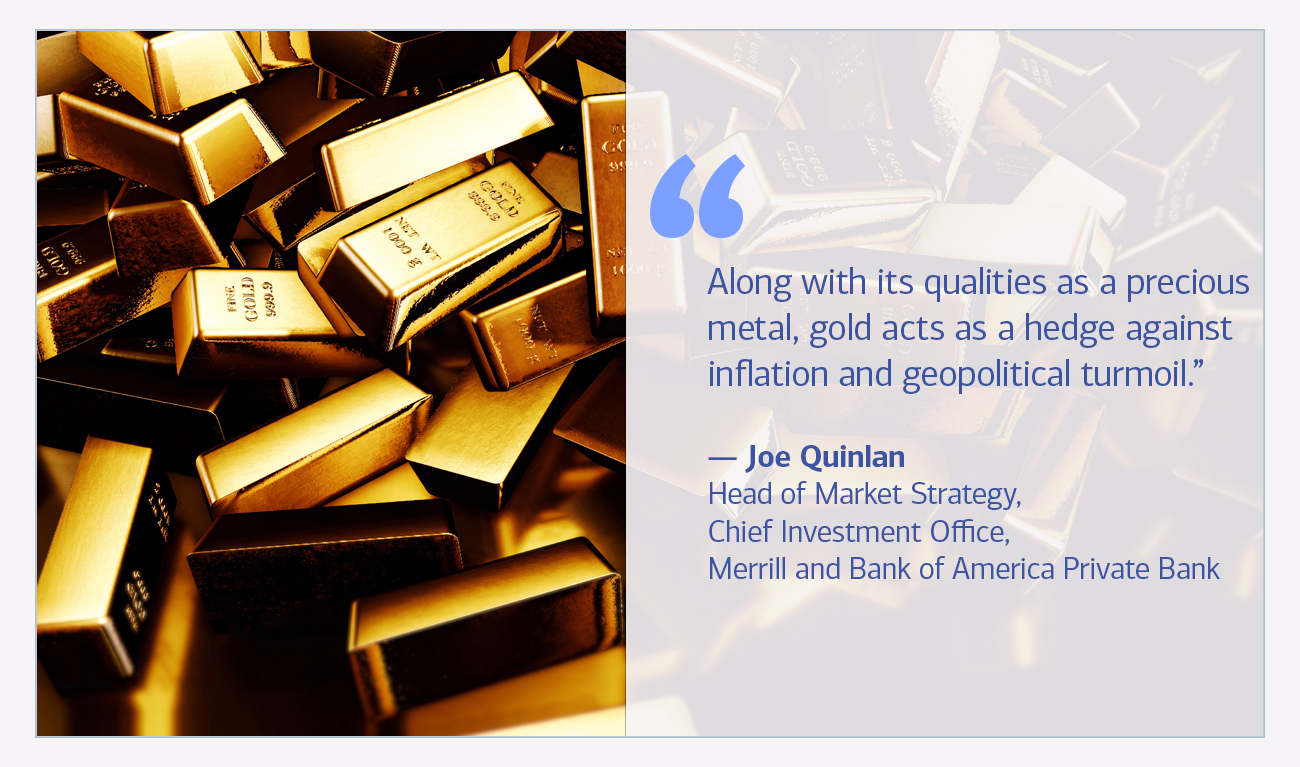
What’s driving the surge?
“Along with its qualities as a precious metal, gold acts as a hedge against inflation and geopolitical turmoil,” Quinlan explains. Those pressures, and growing concerns over U.S. debt and the dollar’s status as a global reserve currency, have contributed to a wave of buying.
“Stockpiling by central banks in 2024 helped gold surpass the euro as the world’s second-leading reserve asset after the dollar,” Quinlan says.3 And 95% of global monetary authorities believe central banks will increase their holding in the next year, one survey showed.4 Another major factor: Investors from China, who together bought roughly 124 metric tons of gold in the first three months of 2025, up 12% from the same period in 2024.5
Does gold have a role in your portfolio?
“Gold can offer investors diversification and long-term growth potential, and there are many ways to purchase it,” Quinlan says. Two prominent options:
- Gold ETFs invest directly in gold or in gold-related areas such as mining. As share owners, investors may benefit if gold values rise, but they don’t own the physical gold.
- Physical gold, purchased in bars or coins, offers direct physical ownership, though storage, security and insurance could add to your costs.
Know the risks
“Prices can be volatile, and recent increases are no guarantee of future value,” Quinlan says. And, unlike bonds or dividend-paying stocks, gold offers no investment income. As such, gold should be considered as a potential addition to your portfolio rather than a substitute for stocks and bonds. Quinlan adds, “An advisor, if you work with one, can help you determine if gold is right for your portfolio and how best to invest.”
Read our recent Capital Market Outlook for more insights on how gold, U.S. debt and other forces are shaping the current investment landscape, and listen to our weekly CIO Market Update audiocast for regular perspectives on market conditions.
1Chief Investment Office, Capital Market Outlook, June 23, 2025.
2BofA Global Research, Global Metals Weekly, June 13, 2025.
3International Monetary Fund; World Gold Council. Data through Q4 2024, latest available..
4World Gold Council, “Central Bank Gold Reserves Survey 2025,” June 17, 2025
5China Daily, “Chinese investors race to buy gold amid uncertainties,” May 2, 2025.
Important Disclosures
Investing involves risk, including the possible loss of principal. Past performance is no guarantee of future results.
Opinions are as of the date of these articles and are subject to change.
Bank of America, Merrill, their affiliates, and advisors do not provide legal, tax, or accounting advice. Clients should consult their legal and/or tax advisors before making any financial decisions.
This information should not be construed as investment advice and is subject to change. It is provided for informational purposes only and is not intended to be either a specific offer by Bank of America, Merrill or any affiliate to sell or provide, or a specific invitation for a consumer to apply for, any particular retail financial product or service that may be available.
The Chief Investment Office (CIO) provides thought leadership on wealth management, investment strategy and global markets; portfolio management solutions; due diligence; and solutions oversight and data analytics. CIO viewpoints are developed for Bank of America Private Bank, a division of Bank of America, N.A., (“Bank of America") and Merrill Lynch, Pierce, Fenner & Smith Incorporated (“MLPF&S" or “Merrill"), a registered broker-dealer, registered investment adviser and a wholly owned subsidiary of Bank of America Corporation (“BofA Corp.”).
BofA Global Research is research produced by BofA Securities, Inc. (“BofAS”) and/or one or more of its affiliates. BofAS is a registered broker-dealer, Member SIPC, and wholly owned subsidiary of Bank of America Corporation.
All recommendations must be considered in the context of an individual investor’s goals, time horizon, liquidity needs and risk tolerance. Not all recommendations will be in the best interest of all investors.
Investments have varying degrees of risk. Some of the risks involved with equity securities include the possibility that the value of the stocks may fluctuate in response to events specific to the companies or markets, as well as economic, political or social events in the U.S. or abroad. Bonds are subject to interest rate, inflation and credit risks. Treasury bills are less volatile than longer-term fixed income securities and are guaranteed as to timely payment of principal and interest by the U.S. government. Investments in a certain industry or sector may pose additional risk due to lack of diversification and sector concentration.
Investments in foreign securities involve special risks, including foreign currency risk and the possibility of substantial volatility due to adverse political, economic or other developments. These risks are magnified for investments made in emerging markets. There are special risks associated with an investment in commodities, including market price fluctuations, regulatory changes, interest rate changes, credit risk, economic changes and the impact of adverse political or financial factors.
Income from investing in municipal bonds is generally exempt from Federal and state taxes for residents of the issuing state. While the interest income is tax-exempt, any capital gains distributed are taxable to the investor. Income for some investors may be subject to the Federal Alternative Minimum Tax (AMT).
Retirement and Personal Wealth Solutions is the institutional retirement business of Bank of America Corporation (“BofA Corp.”) operating under the name “Bank of America.” Investment advisory and brokerage services are provided by wholly owned non-bank affiliates of BofA Corp., including Merrill Lynch, Pierce, Fenner & Smith Incorporated (also referred to as "MLPF&S" or "Merrill"), a dually registered broker-dealer and investment adviser and Member SIPC. Banking activities may be performed by wholly owned banking affiliates of BofA Corp., including Bank of America, N.A., Member FDIC.
You have choices about what to do with your 401(k) or other type of plan-sponsored accounts. Depending on your financial circumstances, needs and goals, you may choose to roll over to an IRA or convert to a Roth IRA, roll over a 401(k) from a prior employer to a 401(k) at your new employer, take a distribution, or leave the account where it is. Each choice may off er different investments and services, fees and expenses, withdrawal options, required minimum distributions, tax treatment (particularly with reference to employer stock), and provide different protection from creditors and legal judgments. These are complex choices and should be considered with care.
Diversification does not ensure a profit or protect against loss in declining markets.
Sustainable and Impact Investing and/or Environmental, Social and Governance (ESG) managers may take into consideration factors beyond traditional financial information to select securities, which could result in relative investment performance deviating from other strategies or broad market benchmarks, depending on whether such sectors or investments are in or out of favor in the market. Further, ESG strategies may rely on certain values based criteria to eliminate exposures found in similar strategies or broad market benchmarks, which could also result in relative investment performance deviating.
Investing in Gold involves special risks, including market price fluctuations, regulatory changes, interest rate changes, credit risk, economic changes, and the impact of adverse political or financial factors.

